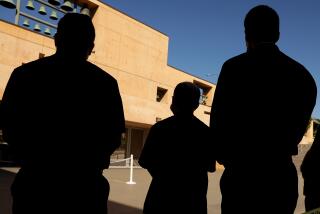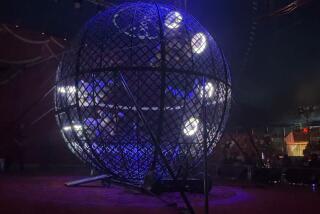Finding Their Religion
- Share via
A man in his 20s faces the congregation at Mission Eben-Ezer Pentecostal Church and delivers startling news.
“I just want to stay out of jail from now on and take care of my family,” he says.
For the record:
12:00 a.m. Aug. 2, 1996 For the Record
Los Angeles Times Friday August 2, 1996 Home Edition Life & Style Part E Page 8 View Desk 1 inches; 24 words Type of Material: Correction
Religious movement--Noel Diaz was misidentified in an article in Thursday’s Life & Style on the Pentecostal movement. He is president of Empire Optical in Los Angeles.
Immediately, an army of people rises from chairs and mobilizes around him, placing hands on his shoulders and above his head in prayer.
Across the room another team is doing the same for a recovering heroin addict who has confessed that he has been clean these last seven years, but somehow, life still has no meaning.
Moments later, the action at this Carson church shifts from high drama to low comedy as the local baseball team slogs onstage for a round of applause. They won this year’s championship.
And the “family” feeling continues when visitors to the church--including a set of grandparents--are introduced.
In between all this, mariachis and bongos back up a hand-waving sing-a-long as well as the playful preaching of the Rev. Isaac Canales. “This is better than Disneyland,” he declares as stories of family abuse, drug addiction and jail terms charge the air in this converted warehouse.
In the midst of Sunday morning service is Ralph Galante.
About once a month, Ralph and his wife, Mary Angela, lifelong practicing Catholics, leave their nearby parish for services at Mission Eben-Ezer, where an estimated 70% of the 600-member congregation was raised Catholic.
They are part of a growing number of Catholics worldwide who during the past 30 years have left their religious roots for the Pentecostal church, with Latin American and Asian countries contributing most to the trend.
In fact, Pentecostalism is now the fastest-growing Christian denomination in the world, with more than 400 million members--one in every four Christians.
And because Latinos account for most of the growth in Catholic churches worldwide, there’s a keen interest in monitoring their choices.
Ultimately, “As Hispanics go, so goes Catholicism,” says Alan Figueroa Deck, a Jesuit and coordinator of Hispanic Pastoral Programs at Loyola University.
In response, the Catholic Church has been studying the Catholic-Pentecostal connection, which includes not just converts but people like the Galantes who are attracted to both traditions. Even Pope John Paul II holds an annual y’all come at the Vatican, inviting top level dialogue from leaders of both churches. Increasingly, the Catholic hierarchy is trying to find ways to add the emotive and folksy Pentecostal flavor to its staid and formal style.
“In the Pentecostal churches people know each other by name,” says 28-year-old Ralph Galante. “They are in each other’s homes during the week, the walls come down and they are like a family, a community. There is a lot Catholics can learn from all this.”
He is also impressed by the answers he gets to questions about Christianity from his Pentecostal friends. Galante, who attended public schools, finds that in the Catholic church, anyone who did not attend parochial school is not as well-informed about their faith.
For Galante, though, the big draw is the Pentecostal approach to social outreach work that makes him feel closer to the congregation and freer to take a leadership role. Mission Eben-Ezer’s dozens of programs are staffed and directed by church members. Until recently in the Catholic tradition, only priests served as directors of programs. The current shortage of clergy has hastened change.
“I see Catholics leaving their own church because they don’t have enough of these kinds of [opportunities],” Galante says. “People are drawn to these one-on-one relationships.” He is about to take his first step in that direction by forming a Catholic Bible study group, a rarity in Catholic churches.
The Galantes plan to remain Catholic, as their religious faith is ingrained in both their families.
“It’s not that the family thinks we’re leaving the church,” says Mary Angela Galante. “Ralph and I have come together on this--we don’t need to leave our faith.”
*
Noel Diaz faced the same dilemma--born Catholic, but drawn to the Pentecostal style. And like Ralph Galante, he decided to stay and try to introduce change.
Ten years ago Diaz, a Mexican-born Catholic with an emotion-packed faith, began leading Pentecostal-style prayer meetings at a friend’s house. Within a few months the house was overflowing with believers.
Now, about 1,000 Spanish-speaking Catholics press into St. Thomas the Apostle Church near downtown L.A.--and the revival meeting-size tent beside it--on Friday nights to hear Diaz preach for an hour.
He invites public testimonies from the many people in the room who have no job, speak no English, claim no permanent address. Near the end of the evening, he calls anyone ready to embrace Jesus as their savior, to come forward to the altar.
What makes this most unusual is that Diaz is not a priest, but the father of three children who owns Empire Optical in Los Angeles. In the Catholic tradition only ordained priests give sermons, and nobody is encouraged to preach for more than 20 minutes.
Diaz says he faced early obstacles at St. Thomas, but he persisted. He started by leading a small prayer gathering in a functions room of the church. The crowd grew. Ten years ago a newly appointed pastor, Father Dennis O’Neill, opened the door of the sanctuary--albeit cautiously.
Three years ago, weekly attendance at Diaz’s gatherings regularly topped 800. Now, people come from around the state. And Cardinal Roger M. Mahony, spiritual leader of the Los Angeles Catholic archdiocese, has given his support.
Diaz is having such a strong impact that Deck, of Loyola University, is sending students and Jesuit seminarians to observe the events at St. Thomas.
“As a country, we now experience ourselves in chronic crisis,” Deck says. “The movement of people to the Pentecostal Church has do to with this crisis, in our families, our country, our world. Churches that respond to the pain, agony and confusion this brings about will grow. Churches that do not, that continue as if it was business as usual, will diminish.”
In the mid-1960s, the Catholic Church formed a charismatic movement based on the expressive Pentecostal style. Its popularity waxes and wanes in suburban, middle-class congregations where prayer groups have formed and retreats are occasionally offered. But in the Latino congregations, such as St. Thomas, the movement continues to grow.
Deck offers a historical reminder that a sedate Christianity is not the only option. The Bible reports all manner of miracles and mystical occurrences in the life of Jesus and the stress-filled days of early church.
“In the context of crisis, a rational, calm approach is problematic,” Deck says. “People want religion with passion.”
Many Catholic congregations and their priests are not prepared to stand up to the huge emotion of a full-tilt, Diaz-style encounter, experts say.
Those who are attend annual church-approved conventions in Southern California by the thousands. Diaz will hold his third such gathering, “Congress of Catholics United in Faith in Los Angeles” later this month. And the Southern California Renewal Communities, which organizes charismatic Masses and prayer gatherings for local parishes, holds its annual event this month in Anaheim.
*
Dominic Bernardino, president of SCRC, has seen problems when Catholics cross over to Pentecostalism. “It can be very divisive in families,” says Bernardino, who gives counsel to Catholics considering the move.
Alma Gonzalez is so distraught over her brother’s conversion that she asked that her real name not be used for this article because her family is just starting to make peace and she doesn’t want to risk more fighting.
“When he left the church it happened slowly,” she says. “His wife did the same. Then after he left, he starting downing us for being Catholics.”
Early on, Gonzalez says her brother criticized the authority of the pope and said religious statues are idols.
“My brother’s mellowed,” Gonzalez says. “But I wouldn’t dare talk to him about my faith. He’d rip it to shreds.”
Such contentiousness filters down from the highest levels, says Russell Spittler, vice president of academic affairs for Fuller Theological Seminary in Pasadena. He has attended Roman Catholic-Pentecostal dialogues held at the Vatican. “They are a help for church leaders to understand the other tradition,” he says. Still, “some in leadership are suspicious. Or worse, positively hostile.”
Canales, of Mission Eben-Ezer, connects these ideas to a fundamentalist attitude found in some Pentecostal congregations. “The pastor sets the tone,” he says.
The Catholic charismatic movement may be helping to break down such barriers.
There are now 80 million members in the movement worldwide, says David Barrett, a leading expert in religious statistics based at the Global Evangelization Movement office in Richmond, Va.
The charismatic movement includes more than Catholics. It has found its way into all the mainline Christian denominations. “You see it among Methodists, Episcopalians, Lutherans. In that sense the charismatic movement is about the closest we’ve come so far to the Christian ideal--that all may be one.”
More to Read
Sign up for Essential California
The most important California stories and recommendations in your inbox every morning.
You may occasionally receive promotional content from the Los Angeles Times.










